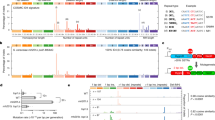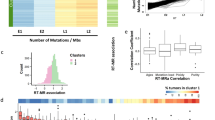Abstract
Trp53 is arguably the most critical tumour suppressor gene product that inhibits malignant transformation. Besides mutations that inactivate Trp53 functions, genetic polymorphisms have been suggested to be risk factors for cancer. A polymorphic site at codon 72 in exon 4 encodes either an arginine amino acid (Trp5372R) or a proline residue (Trp5372P). Previous studies have shown that the Trp5372R form is more efficient in apoptosis induction, whereas the Trp5372P form was suggested to induce G1 arrest better. Here we report that Trp5372P is more efficient than Trp5372R in specifically activating several Trp53-dependent DNA-repair target genes in several cellular systems. Moreover, using isogenic cell lines and several DNA-repair assays, we show that Trp5372P cells have a significantly higher DNA-repair capacity than the Trp5372R cells. Furthermore, Trp5372P-expressing cells exhibit reduced micronuclei formation compared to Trp5372R-expressing cells, suggesting that genomic instability is reduced in these cells. Together, the data highlight the functional differences between the Trp53 polymorphic variants, and suggest that their expression status may influence cancer risk.
This is a preview of subscription content, access via your institution
Access options
Subscribe to this journal
Receive 50 print issues and online access
$259.00 per year
only $5.18 per issue
Buy this article
- Purchase on Springer Link
- Instant access to full article PDF
Prices may be subject to local taxes which are calculated during checkout







Similar content being viewed by others
References
Akyuz N, Boehden GS, Susse S, Rimek A, Preuss U, Scheidtmann KH et al. (2002). Mol Cell Biol 22: 6306–6317.
Bergamaschi D, Gasco M, Hiller L, Sullivan A, Syed N, Trigiante G et al. (2003). Cancer Cell 3: 387–402.
Bond GL, Hu W, Bond EE, Robins H, Lutzker SG, Arva NC et al. (2004). Cell 119: 591–602.
Brown JM, Attardi LD . (2005). Nat Rev Cancer 5: 231–237.
Buchman VL, Chumakov NN, Ninkina NN, Samarina OP, Georgiev GP . (1988). Gene 70: 245–252.
Chipuk JE, Green DR . (2003). J Clin Immunol 23: 355–361.
Cho HJ, Jeong HG, Lee JS, Woo ER, Hyun JW, Chung MH et al. (2002). J Biol Chem 277: 19358–19366.
Critchlow SE, Jackson SP . (1998). Trends Biochem Sci 23: 394–398.
Dahm-Daphi J, Hubbe P, Horvath F, El-Awady RA, Bouffard KE, Powell SN et al. (2005). Oncogene 24: 1663–1672.
Donehower LA, Harvey M, Slagle BL, McArthur MJ, Montgomery Jr CA, Butel JS et al. (1992). Nature 356: 215–221.
Dumont P, Leu JI, Della Pietra III AC, George DL, Murphy M . (2003). Nat Genet 33: 357–365.
Evans SC, Lozano G . (1997). Mol Med Today 3: 390–395.
Fenech M, Crott JW . (2002). Mutat Res 504: 131–136.
Friedlander P, Legros Y, Soussi T, Prives C . (1996). J Biol Chem 271: 25468–25478.
Ghebranious N, Donehower LA . (1998). Oncogene 17: 3385–3400.
Hanawalt PC, Ford JM, Lloyd DR . (2003). Mutat Res 544: 107–114.
Harris N, Brill E, Shohat O, Prokocimer M, Wolf D, Arai N et al. (1986). Mol Cell Biol 6: 4650–4656.
Haupt S, Berger M, Goldberg Z, Haupt Y . (2003). J Cell Sci 116: 4077–4085.
Hwang BJ, Ford JM, Hanawalt PC, Chu G . (1999). Proc Natl Acad Sci USA 96: 424–428.
Jacks T, Remington L, Williams BO, Schmitt EM, Halachmi S, Bronson RT et al. (1994). Curr Biol 4: 1–7.
Karran P . (2000). Curr Opin Genet Dev 10: 144–150.
Kastan MB, Zhan Q, el-Deiry WS, Carrier F, Jacks T, Walsh WV et al. (1992). Cell 71: 587–597.
Lahav G . (2004). Sci STKE 264: 55.
Langerod A, Bukholm IR, Bregard A, Lonning PE, Andersen TI, Rognum TO et al. (2002). Cancer Epidemiol Biomarkers Prev 11: 1684–1688.
Lee MK, Hande MP, Sabapathy K . (2005). J Cell Sci 118: 819–829.
Lin Y, Waldman BC, Waldman AS . (2003). DNA Repair 2: 1–11.
Mallya SM, Sikpi MO . (1998). Evidence of the involvement of p53 in gamma-radiation-induced DNA repair in human lymphoblasts. Int J Radiat Biol 74: 231–238.
Matlashewski GJ, Tuck S, Pim D, Lamb P, Schneider J, Crawford LV . (1987). Mol Cell Biol 7: 961–963.
Matsuoka A, Yamazaki N, Suzuki T, Hayashi M, Sofuni T . (1992). Mutat Res 272: 223–236.
McGregor JM, Harwood CA, Brooks L, Fisher SA, Kelly DA, O'nions J et al. (2002). J Invest Dermatol 119: 84–90.
Michalovitz D, Halevy O, Oren M . (1990). Cell 62: 671–680.
Okorokov AL, Warnock L, Milner J . (2002). Carcinogenesis 23: 549–557.
Olivier M, Hussain SP, Caron de Fromentel C, Hainaut P, Harris CC . (2004). IARC Sci Publ 157: 247–270.
Oren M . (2003). Cell Death Differ 10: 431–442.
Papadakis EN, Dokianakis DN, Spandidos DA . (2000). Mol Cell Biol Res Commun 3: 389–392.
Patrick MH . (1977). Photochem Photobiol 25: 357–372.
Pim D, Banks L . (2004). Int J Cancer 108: 196–199.
Rauth S, Kichina J, Green A, Bratescu L, Das Gupta TK . (1994). Anticancer Res 14: 2457–2463.
Risinger MA, Groden J . (2004). Cancer Cell 6: 539–545.
Schuler M, Green DR . (2001). Biochem Soc Trans 29: 684–688.
Schwarz A, Stander S, Berneburg M, Bohm M, Kulms D, van Steeg H et al. (2002). Nat Cell Biol 4: 26–31.
Sengupta S, Harris CC . (2005). Nat Rev Mol Cell Biol 6: 44–55.
Siddique MM, Balraqm C, Fiszer-Maliszewska L, Aggarwal A, Tan P, Soo KC et al. (2005). Cancer, Epidemiology, Biomarkers and Prevention 14: 2245–2252.
Själander A, Birgander R, Hallmans G, Cajander S, Lenner P, Athlin L et al. (1996). Carcinogenesis (London) 17: 1313–1316.
Smith ML, Ford JM, Hollander MC, Bortnick RA, Amundson SA, Seo YR et al. (2000). Mol Cell Biol 20: 3705–3714.
Stopper H, Eckert I, Wagener P, Schulz WA . (1997). Recent Results Cancer Res 143: 183–193.
Storey A, Thomas M, Kalita A, Harwood C, Gardiol D, Mantovani F et al. (1998). Nature 393: 229–234.
Sullivan A, Syed N, Gasco M, Bergamaschi D, Trigiante G, Attard M et al. (2004). Oncogene 23: 3328–3337.
Tanaka H, Arakawa H, Yamaguchi T, Shiraishi K, Fukuda S, Matsui K et al. (2000). Nature (London) 404: 42–49.
Tang W, Willers H, Powell N . (1999). Cancer Res 59: 2562–2565.
Thoday JM . (1951). Br J Radiol 24: 572–576.
Thomas M, Kalita A, Labrecque S, Pim D, Banks L, Matlashewski G . (1999). Mol Cell Biol 19: 1092–1100.
Toh WH, Kyo S, Sabapathy K . (2005). J Biol Chem 280: 17329–17338.
Vikhanskaya F, Siddique MM, Lee MK, Broggini M, Sabapathy K . (2005). Clin Cancer Res 11: 4348–4356.
Vogelstein B, Lane D, Levine AJ . (2000). Nature 408: 307–310.
Vousden KH, Lu X . (2002). Nat Rev Cancer 2: 594–604.
Wani MA, Wani G, Yao J, Zhu Q, Wani AA . (2002). Carcinogenesis (London) 23: 403–410.
Weston A, Godbold JH . (1997). Environ Health Perspect 105: 919–926.
Yang T, Namba H, Hara T, Takmura N, Nagayama Y, Fukata S et al. (1997). Oncogene 14: 1511–1591.
Yang WL, Cvijic ME, Ishii K, Chin KV . (1998). Biochem Biophys Res Commun 250: 593–597.
Zhang W, Guo XY, Hu GY, Liu WB, Shay JW, Deisseroth AB . (1994). EMBO J 13: 2535–2544.
Acknowledgements
We thank Dr P Hande for advise and help with micronuclei analysis and Drs H Arakawa and D Gupta for plasmids and cell lines. We thank the National Medical Research Council, Singapore, for their generous funding and support to KS.
Author information
Authors and Affiliations
Corresponding author
Rights and permissions
About this article
Cite this article
Siddique, M., Sabapathy, K. Trp53-dependent DNA-repair is affected by the codon 72 polymorphism. Oncogene 25, 3489–3500 (2006). https://doi.org/10.1038/sj.onc.1209405
Received:
Revised:
Accepted:
Published:
Issue Date:
DOI: https://doi.org/10.1038/sj.onc.1209405
Keywords
This article is cited by
-
Polymorphisms in MDM2 and TP53 Genes and Risk of Developing Therapy-Related Myeloid Neoplasms
Scientific Reports (2019)
-
TP53 Arg72 as a favorable prognostic factor for Chinese diffuse large B-cell lymphoma patients treated with CHOP
BMC Cancer (2017)
-
Potential impact of (rs 4645878) BAX promoter −248G>A and (rs 1042522) TP53 72Arg>pro polymorphisms on epithelial ovarian cancer patients
Clinical and Translational Oncology (2016)
-
p53 Arg72Pro polymorphism confers the susceptibility to endometriosis among Asian and Caucasian populations
Archives of Gynecology and Obstetrics (2016)
-
Association of TP53 gene polymorphisms with susceptibility of bladder cancer in Bangladeshi population
Tumor Biology (2015)



